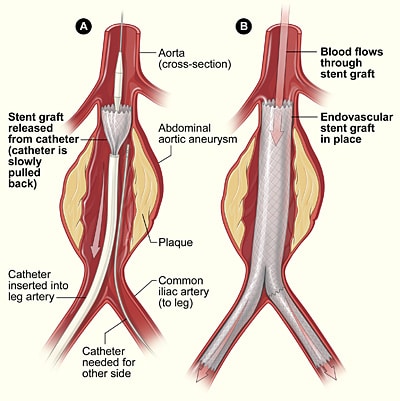This article is for educational purposes only. It should not be used as a template for consenting patients. The person obtaining consent should have clear knowledge of the procedure and the potential risks and complications. Always refer to your local or national guidelines, and the applicable and appropriate law in your jurisdiction governing patient consent.
Overview of Procedure
An endovascular abdominal aortic aneurysm repair involves introducing a graft into the aorta via the femoral arteries and fixing a stent across the aneurysm. It creates a seal below the renal arteries, and in the iliac arteries, thus excluding the aneurysmal segment.
The consent for Fenestrated EVAR, Branched EVAR, or Chimney EVAR would be the same, however with increased risk of morbidity and mortality, particularly a higher risk of renal failure and bowel ischaemia.
Intra-Operative Complications
| Complication | Description | Potential Ways to Reduce Risk |
| Conversion to Open Repair | There is an extremely small possibility that the stent cannot pass through the iliac arteries, or that the stent causes the aorta to rupture, necessitating either cessation of the procedure, or conversion to open repair. | |
| Nerve Injury | The patient may notice a numb patch of skin around or below the groin incision due to damage to superficial nerves. | |
| Anaesthetic Risks | Includes damage to the teeth, throat and larynx, reaction to medications, nausea and vomiting, cardiovascular and respiratory complications. | Forms a part of the anaesthetist assessment before the operation |
Early Complications
| Complication | Description | Potential Ways to Reduce Risk |
| Pain | Local anaesthesia will be used in the femoral incisions, however chronic pain from damage to the femoral nerve or its branches is possible. | |
| Bleeding | There will be a small volume of blood lost during surgery. There is a small chance of bleeding and bruising in the groin post-surgery. | |
| Infection | Superficial wound infection is possible, however graft infection if occurs is a major complication requiring life-long antibiotics and graft excision if possible.
Chest infection is possible although less common in local anaesthetic procedures. |
Peri-operative antibiotics will reduce the risk of wound and graft infections |
| Scarring | Groin incisions will result in a scar, which may form a keloid scar, particular in high risk ethnicities. | |
| Seroma | A swelling of lymphatic fluid may occur in the groin wounds due to disruption of the lymph nodes and channels. | |
| Blood Clots | DVTs and PEs are a possibility in any operation. The risk is increased in patients with a raised BMI, on the pill, recent flights, previous DVT, pregnancy, smokers, cancer and prolonged bed rest. | The patient will be given anti-embolism stocking and low molecular weight heparin to minimise this risk as deemed appropriate. |
| Bowel Ischaemia | The inferior mesenteric artery is occluded during the procedure. Collateral circulation from the superior mesenteric artery and coeliac axis will usually prevent this complication, however in cases of SMA or coeliac stenosis bowel ischaemia may occur. | |
| Stroke, MI, Kidney Failure, Death | Although small, this is always a risk in any major surgery |
Late Complications
| Complication | Description |
| Endoleak | An incomplete seal of the aneurysm, whereby begins to blood leak around the graft (more detail found here) |
| Migration | Movement of the stent downwards thus disrupting the seal zone at the top of the graft, leading to a Type Ia endoleak. |
| Limb occlusion | A kink or narrowing in the stent limb can lead to occlusion and acute limb ischaemia, requiring thrombolysis, embolectomy, or a femoro-femoral crossover graft. |
| Impotence | An alteration in the blood supply to the pelvis can cause impotence |
| Reintervention | There is a 20% chance of a further operation to repair the endovascular stent-graft. This would be due to any of the complications listed above and is usually performed under local anaesthesia through the groin. |

